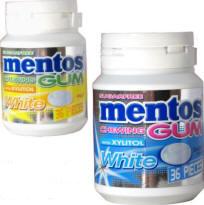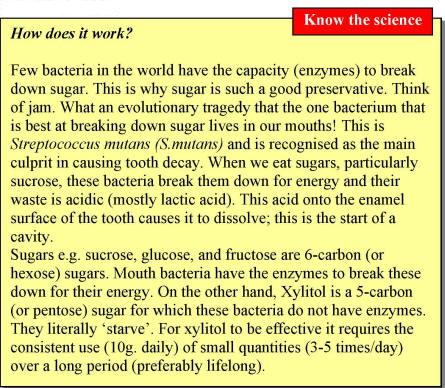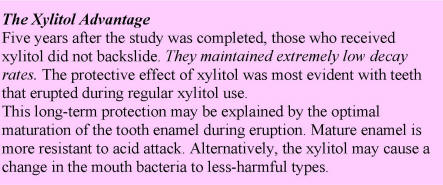Xylitol
You will see from the prevention jigsaw (see page 93) that Xylitol is one of the key elements in the prevention of dental decay. Many people may not even be aware of its existence.
What is Xylitol?
Its a natural sweetener found in many fruits and vegetables (e.g. berries, mushrooms, corn, and almonds). Its even produced in our own bodies. Xylitol was commercially developed in Finland to satisfy sugar shortages during World War II. Spoon for spoon, it is as sweet as sugar (sucrose). Because it is 40% lower in calories, it is now sold widely in weight-loss programs. Its refreshing taste, and no bitter after-taste, has made it very popular. Xylitol is termed a nutraceutical, a food substance with medical benefits.
Why is it good for you?
Dental studies have highlighted its protection against tooth decay. An early study showed a 90% reduction in decay when Xylitol replaced sucrose in the diet! Later studies, using smaller amounts of Xylitol, have confirmed these dramatic benefits. The key is to have small quantities of Xylitol throughout the day, and over a long period. Xylitol has also been shown to have benefits in preventing middle ear and sinus infections.
How much Xylitol?
 The best way of eating Xylitol is to chew sugar-free Xylitol chewing gum.
Mums are quite surprised when I recommend chewing gum for their
children. I am absolutely opposed to sugar containing gums, but
sugar-free chewing gum with xylitol is a must! Children
love it because of its refreshing, sweet taste: in fact, when I
recommend it everyday and after every meal and
snack, they get even more excited! Not all sugar-free gums
contain Xylitol. Choose one with Xylitol as the principal
sweetener (i.e. listed first on the ingredients label).
Alternatively, 100% Xylitol sweets are available (certain Smints
or Spry range).
The best way of eating Xylitol is to chew sugar-free Xylitol chewing gum.
Mums are quite surprised when I recommend chewing gum for their
children. I am absolutely opposed to sugar containing gums, but
sugar-free chewing gum with xylitol is a must! Children
love it because of its refreshing, sweet taste: in fact, when I
recommend it everyday and after every meal and
snack, they get even more excited! Not all sugar-free gums
contain Xylitol. Choose one with Xylitol as the principal
sweetener (i.e. listed first on the ingredients label).
Alternatively, 100% Xylitol sweets are available (certain Smints
or Spry range).
- Quantity : 10 grams per day.
- Frequency : at least 3, preferably 5 times, per day.
- Timing : after meals and snacks : between meals :
- before bedtime.
Consistency : use every day.
![]() Use Xylitol gum:
Use Xylitol gum:
- Instead of sweets.
- In the car to and from school.
- After giving medicines.
- At sports events.
After parties We particularly recommend it for:
- Children (high risk).
- Orthodontic cases (high risk).
- Pregnant & new moms (lowers baby's risk).
- Athletes (dry mouth).
- Special needs (medications).
- Middle ear infections (prevention).
We return a lot to the concept of repair or healing in our mouths (see HealOzone page 82). Food and drinks, particularly in our refined 21st century diets, pose a daily challenge to our teeth. Nature was incredible to have systems within our mouths to handle acid challenges. Think of Natures Cavity fighter, saliva, with its buffering systems. Think of saliva with its calcium and phosphate to repair teeth after an acid attack. In early man, the balance of destruction (acid attack) was balanced with repair. Result: no tooth decay. Fast forward to present day: high bacterial levels, due too high sugar diets, have tipped the balance in favour of breakdown. Xylitol is one element in righting this balance. The powerful protective effect of xylitol was most evident in children's teeth which erupted during regular xylitol use. Children's teeth,, both baby and permanent ones, are most susceptible to decay when they first erupt. The enamel is said to be immature. With time, minerals from the saliva are deposited in the outer enamel surface which makes it harder and more resistant to acid attack (see page 78). This explains why our teeth become more resistant to decay with time and why tooth decay is a disease of childhood. Studies using xylitol in chewing gum have demonstrated:
- Dramatic reduction in new tooth decay.
- Arrest or reversal of existing decay.
Effect is long-lasting, possibly permanent Low decay rates persist even years after the scientific trials have been completed. Mothers who used xylitol gum from 3 months after delivery until the child was 2ys. old, reduced the S.mutans levels in their children's mouths up to 6 years of age. The process of chewing gum, in itself, stimulates the saliva. Saliva flows into our mouth at a slow rate all the time (see page 138). However, when it is stimulated, it flows at a much faster rate. It also has a different consistency i.e. it is richer in bicarbonate which neutralizes acids.

If my child gets fluoride, isn't that sufficient?
No! The studies have been done in Finland which looked at children at low risk from tooth decay and those at high risk. Both received fluoride in toothpaste and as supplements. In both groups it was shown that decay could be reduced if Xylitol gum were given, in addition, 3 or more times a day.

Excerpt from 'The ABC's of children's teeth' pages 151,152


